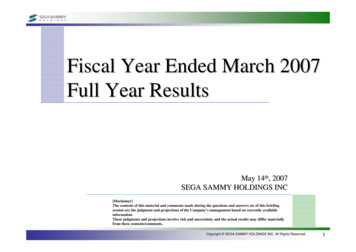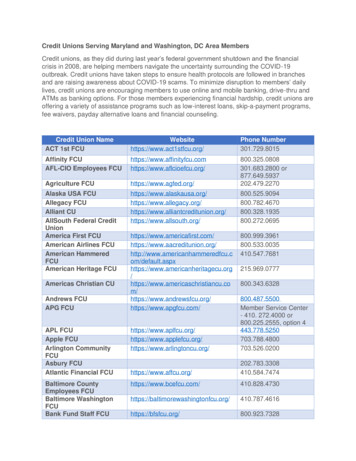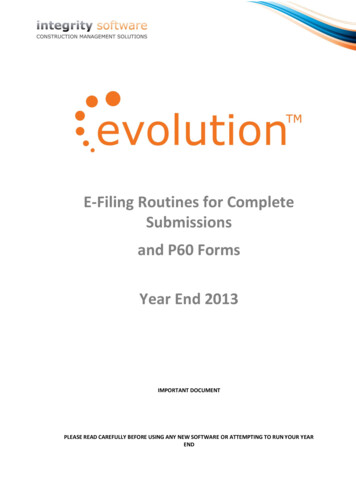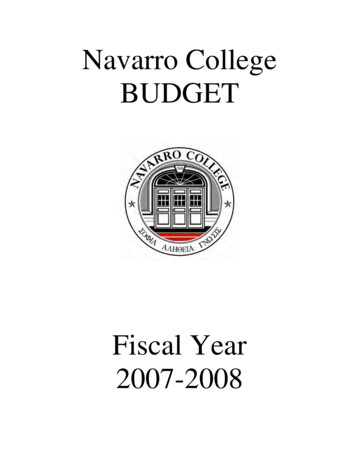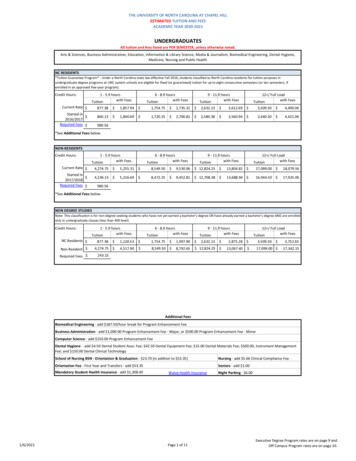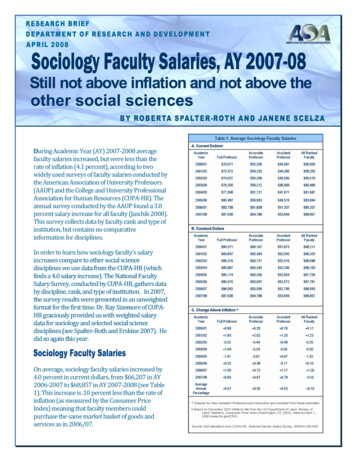
Transcription
During Academic Year (AY) 2007‐2008 averagefaculty salaries increased, but were less than therate of inflation (4.1 percent), according to twowidely used surveys of faculty salaries conducted bythe American Association of University Professors(AAUP) and the College and University ProfessionalAssociation for Human Resources (CUPA‐HR). Theannual survey conducted by the AAUP found a 3.8percent salary increase for all faculty (Jaschik 2008).This survey collects data by faculty rank and type ofinstitution, but contains no comparativeinformation for disciplines.In order to learn how sociology faculty’s salaryincreaseseases compare to other social sciencedisciplines we use data from the CUPA‐HR (whichfinds a 4.0 salary increase). The National FacultySalary Survey, conducted by CUPA‐HR, gathers databy discipline, rank, and type of institution. In 2007,the survey results were presented in an unweightedformat for the first time. Dr. Ray Sizemore of CUPA‐HR graciously provided us with weighted salarydata for sociology and selected social sciencedisciplines (see Spalter‐Roth and Erskine 2007). Hedid so again this year.On average, sociology faculty salaries increased by4.0 percent in current dollars, from 66,207 in AY2006‐2007 to 68,857 in AY 2007‐2008 (see Table1). This increase is .10 percent less than the rate ofinflation (as measured by the Consumer PriceIndex) meaning that faculty members couldpurchase the same market basket of goods andservices as in 2006/07.
Some common items in their market baskets suchas gasoline, health care, and college tuitionoutpaced inflation, so that the result is probably adecline in living standards. Table 1 presents theaverage increase for all faculty members in currentand constant dollars since AY 2000‐2001 and thechange above or below inflation in each year.When adjusted for inflation, the table shows a .09increase above the rate of inflation since AY 2000‐2001. The average sociology faculty salaryincreased by 12,207 or 22 percent (in currentdollars) since AY 2000‐2001. When salaries werecontrolled for inflation, the increase was 646.Sociology professors lost buying power in four outof the last seven academic years. Overall sociologysalaries have been flat in terms of purchasingpower for the last seven years. Figure 1 illustratesthis point. The trend line for salaries in currentdollars shows a slow but steady upward increase,while the trend line for constant dollars illustratesno growth. When we examine faculty by rank,those in positions from assistant through fullprofessors did better than faculty overall. In AY2007‐2008, full professors earned an average of 87,938, associate professors earned an average of 64,788, and assistant professors earn an averageof 53,844 (see Table 1A, 1B, and 1C). For those infull, associate, and assistant faculty positions, theincrease between AY 2006‐2007 and AY 2007‐2008 in constant dollars was slightly above therate of inflation at 5.0 percent, 4.7 percent, and 4.8percent (see Table 1C).Source: ASA Tabulation from CUPA-HR, National Faculty SalarySurvey, 2000/01 – 2007/08.2Since AY 2000‐2001, these salaries were slightlygreater than the rate of inflation with fullprofessors earning an additional 3,567, associateprofessors earning an additional 1,771, andassistant professors earning an additional 1,971 inconstant dollars. As can be seen, associateprofessors saw the smallest salary increase overthe eight‐year period and experienced threestraight years of salary declines between AY 2002‐2003 and AY 2004‐2005. The salaries for newassistant professors increased from 49,735 in AY2006‐2007 to 52,446 for a 5.4 percent increase—the highest increase of all ranks of sociology faculty.It is those with positions as instructors whosesalaries in constant dollars have continued todecrease. Their salaries in current dollarsincreased from 40,015 in AY 2006‐2007 to 40,522 in AY 2007‐2008, for a 1.3 percent
increase substantially below the rate of inflation.Figure 2 shows the consistent uptick in salaries incurrent dollars for all three professorial ranks (withfull professors having a steeper trend line) duringthis period. In contrast, Figure 3 shows the flat lineswhen the salaries of these three ranks of faculty arecalculated in constant dollars.According to AAUP data, the salary gap betweenpublic and private institutions has grown over thelast two years (Jaschik 2008). We find similarresults for sociology faculty in these types ofinstitutions. Across types, there is probably themost diversity within private institutions; theyinclude the richest universities in the country alongwith small church‐related schools. When averaged,however, private universities saw larger sociologysalary increases than public universities. In thiscase, the findings are based on unweighted datasince weighted data were not available. BetweenAY 2006‐2007 and AY 2007‐2008, the averagefaculty salary in private institutions increased 4.6percent or 0.5 percent above inflation. In contrast,average salaries for public institutions increased by3.3 percent or 0.8 percent less than the rate ofinflation.How does sociology compare with its sister socialsciences? Over the last academic year it did not fareas well as political science and economics.Sociology and anthropology salaries did not keepup with inflation. As Table 2 shows, politicalscientists received the largest raise and 1.27percentage points over inflation. Economics thediscipline whose pay level is substantially higherthan the other social science disciplines received araise that was 0.27 percentage points aboveinflation. Some of the differences in average salariesamong the social sciences, and especially therelatively low salaries of sociologists can beexplained, by variation in the structuralcomposition of the four disciplines. Economics, thediscipline with the highest average salary had thegreatest share of high‐paid full professors (43.5percent) and the smallest share of lower‐paidassistant professors (26.5 percent). In contrast,only 35.4 percent of sociology faculty was fullprofessors and almost an equal share (32.1 percent)were assistant professors. Anthropology andpolitical science have rank structures that fellbetween the two extremes.Disciplinary structure probably does not accountfor all of the salary differences among social andbehavioral sciences. The higher salaries in3
economics may be the result of the demand foreconomists outside the academy, with about 45percent of PhD economists holding non‐academicjobs (compared to 17 percent of sociologists)and/or the location of many economicsdepartments in higher‐paying schools of businessrather than colleges of arts and sciences.private institutions may continue to grow unlessstate budgets continue to shrink.If state budget deficits remain, current and futuresociology graduate students may experiencegrowing financial pressures and greater numbersmay seek employment outside the academy, ingovernment, non‐profit, and for‐profit settings.Sociology as a discipline could follow economicsand encourage PhDs to look for jobs beyond theivory tower. These non‐academic positions tend tobe higher paid than faculty positions. In 2003, thelast year for which data is published, sociologistsearned an average of 83,000 in the non‐profitsector, 86,000 in the for‐profit sector, and 99,000in the federal government. (National ScienceWhat does the future hold for sociology faculty?The AY 2000‐2001 through AY 2007‐2008 datasuggest that purchasing power of sociology facultywill remain flat unless there are major salaryincreases in the next few years. These increases willbe more likely for public institutions if state budgetoutlays grow rather than decline. During thecurrent fiscal year, many states faced dramaticincreases in budget deficits, although someattempted to protect higher education fromcutbacks (Hebel 2008). Deficits often result in flatsalaries for faculty. The gap between public andFoundation, Division of Science Resource Statistics, Survey ofDoctoral Recipients. Retrieved April 20, 54.pdf ).Future salaries for sociology PhDs might increase asa result of greater competition for sociology PhDsby government or firms in the for‐profit or non‐profit sector, especially in the health sector—thelargest employer of non‐faculty sociology PhDs.CUPA‐HR. 2008. 2007‐2008 National Faculty Salary Survey by Discipline and Rank in four Year Colleges andUniversities. Knoxville, TN: College and University Professional Association for Human Resources.Jaschik, Scott. 2008. “Faculty Salaries and Priorities.” Inside Higher Education. April 14. Retrieved April 14, .Hebel, Sara. 2008. “State Revenues Are Near a 5‐Year Low, Report Says Report.” Chronicle of Higher Education.April 11. Retrieved April 15, 2008. palter‐Roth, Roberta and William Erskine. 2007. Sociology and Other Social Science Salary Increases: Past,Present, and Future. Washington, DC: American Sociological Society. Retrieved April 20, ryRschBrief51807.pdf4
5
the American Association of University Professors (AAUP) and the College and University Professional Association for Human Resources (CUPA‐HR). The annual survey conducted by the AAUP found a 3.8 percent
